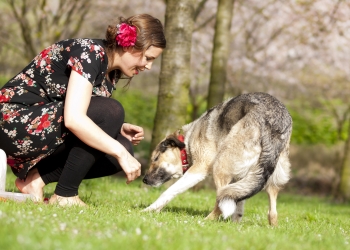×
Email
HOW CAN WE HELP?
6a - 7p Monday - Friday
6a - 2p Saturday
Mountain Time
PHONE
1-877-738-7237
FAX
1-866-777-1434
MAIL
Pets Best
2323 S Vista Ave. Ste. 100
Boise, ID 83705
My Question
First Name
Last Name
Policy (optional)
Phone
Best Day
Best Time
Click here to text customer care
- Pet Insurance
- Blog
- Reasons Why Dogs Growl While Their Tail Wags

When you really think about it, our dogs need to be bi-lingual. They not only must understand verbal and non-verbal cues from other canines, but they must comprehend what we are saying to them.
Our dogs are far better at interpreting “people speak” than many people are at correctly deciphering “dog speak.” Classic example: a dog wags his tail while getting head scratches, belly rubs or even hand massages down the spine. Suddenly, without warning or explanation (at least in the minds of us two-leggers), he starts growling.
What’s going on? Is the dog suddenly switching from a state of bliss into one of agitation? Should you stop and back away, or continue petting him?
For your safety, stop petting.
“A wagging tail doesn’t cause physical harm. Unfortunately, far too often, people mistakenly pay more attention to the tail action than to the front end of the dog, specifically the mouth displaying a full set of sharp teeth,” cautions Alice Moon-Fanelli, Ph.D., a certified applied animal behaviorist in private practice in Eastford, CT.
She urges you to look at and assess the total dog before bending down and offering a belly rub. Some cunning canines use this belly-up posture with tails wagging side to side to lure unsuspecting people for growl, or even worse, bite attacks. These dogs make direct, hard stares and tense their bodies – warning signals that they are about to growl, snap or bite.
Growls come in different durations and pitches. The growl doesn’t always mean “back off,” which is why it is vital to assess what’s going on from head to tail before approaching or petting a dog.
Consider these three very different growl scenarios:
1. A confident dog wanting you to move away will often deliver a low-pitched warning growl. His body will stiffen and the loose circular wag may become a stiff side-to-side motion.
2. A scared dog who really doesn’t want to defend himself may make a high-pitched growl-bark to get you to move away from him.
3. A happy dog attempting to solicit you to play with him may let out a few short growls as he plops into a play bow (his front legs are extended while he raises his rear end) and his body is relaxed, not tense. His eyes are soft, too.
Her take-home safety message: pay attention to the end of the dog that can really hurt you – the front end with the big teeth. When approaching a dog, be alert and avoid being one of these three types of people:
• The Clueless: This person mindlessly approaches a dog head on.
• The Caretaker: This person assumes a dog is scared and needs to be comforted.
• The Controller: This person believes he can overpower any dog with stern talk.
The best way to engage in a meaningful two-way “conversation” with your dog is to speak less and stop, look and listen to what your dog is trying to tell you. After all, the best communication always involves sharing and receiving. Learning to “speak dog” will help bolster a stronger friendship bond with your dog.
Like This Article?
Our Best Articles, Delivered Monthly!